Music is the universal language
“Glory to God in the highest heaven, and on earth peace to those on whom his favor rests.” - Luke 2:14
General Interest
“For the most part, new products in the pedal world are just different colored housings of the same circuits we’ve all been using for decades”: What does a Dumble-whispering tone nut keep on his pedalboard? Ask Kenny Wayne Shepherd...
"You might not get close to his virtuosity but the sounds are here": Epiphone Jeff Beck 1954 Les Paul Oxblood review
Mick Ralphs of Bad Company and Mott the Hoople Dies at 81

Mick Ralphs’ burly guitar tone and arrangements made “Ready for Love,” “Can’t Get Enough,” “Bad Company,” “Feel Like Makin’ Love,” and others part of the soundtrack of the ’70s.
English guitarist, vocalist, and songwriter Mick Ralphs was among a select group of performers who achieved both consistent commercial success and artistic triumph throughout a career that extended from the mid-’60s until 2016, when a stroke led to his hospitalization and, eventually, retirement. Ralphs, who died on Monday, June 23, at age 81, was a founding member of two seminal British rock bands, Mott the Hoople and Bad Company. But he also had other collaborations and led groups that faithfully performed the other idiom he loved besides rock—the blues. Bad Company was recently voted into the Rock and Roll Hall of Fame, with its induction ceremony scheduled for November. His co-founding Bad Company member Paul Rodgers issued a statement Monday on the group’s website shortly after the news broke.
“Our Mick has passed; my heart just hit the ground,” Rodgers said. “He has left us with exceptional songs and memories. He was my friend, my songwriting partner, an amazing and versatile guitarist who had the greatest sense of humor. Our last conversation was a few days ago, we shared a laugh, but it won’t be our last. There are many memories of Mick that will create laughter. Condolences to everyone who loved him—especially his one true love, [Ralphs’ wife] Susie. I will see you in heaven.”
Ralphs was born in 1944 in the Western English county of Herefordshire, and began playing with blues bands in his teens. As a soloist, Ralphs could deliver either flashy, speedy licks or thoughtful, intricate riffs and phrases. His songwriting prowess reflected an ability to create catchy lyrics and pen engaging melodies that would hook audiences. His fame and recognition expanded during his tenure in Mott the Hoople. Initially known as the Doc Thomas Group, and later the Shakedown Sound and/or Silence, the band began in 1966 with Ralphs on guitar, vocalist Stan Tippis, and bassist Pete Overend Watts. Later they added drummer Dale “Buffin” Griffin and organist Verden Allen.
They changed their name to Mott the Hoople after signing with Island in 1969, doing so on a request from producer Guy Stevens. He’d read a novel by Willard Manus titled Mott the Hoople, about an eccentric working in a circus freak show. Before releasing their debut album, Ian Hunter was recruited as frontman. The band’s early records didn’t make much impact, but David Bowie was a fan of their sound. He penned their first huge hit, “All The Young Dudes,” and produced their breakout LP of the same name in 1972. The Bowie influence heavily shifted the band’s idiomatic focus to glam. Still, Ralphs had one of his first big hits as a songwriter, “Rock and Roll Queen,” while with them. He also wrote a tune that would become a much bigger hit later: “Ready For Love.”

Ralphs’ dynamic guitar style would be headlined on yet another Hoople hit, “Roll Away the Stone.” This came right before he departed the band in 1973, in large part due to tensions with Hunter. Their beef even reached the rock press, though Ralphs’ decision would lead to a different pathway and subsequently more personal success as an instrumentalist and songwriter. He’d developed a friendship with vocalist Paul Rodgers, who’d also recently left the band Free. What was first viewed as only a writing partnership blossomed into a recording session, and drummer Simon Kirke asked to sit in. They would recruit former King Crimson member Boz Burrell as the bassist, and Bad Company was born. The self-titled debut LP topped the charts, Ralphs’ tune “Can’t Get Enough” (also known as “Can’t Get Enough of Your Love”) reached number five on Billboard Hot 100, and the album was ultimately certified as a five-times-platinum seller.
Instantly identifiable power chords, crackling riffs, and engaging, entertaining lyrics were the assets of the best Bad Company singles and albums. Ralphs’ array of compositional gems also included “Good Lovin’ Gone Bad,” and a re-recorded, bigger hit version of “Ready for Love.” In addition, he co-wrote “Bad Company,” “Feel Like Makin’ Love,” and many other staples of the classic-rock canon. Bad Company cut 12 albums in one incarnation or another between 1974 and 1996. Ralphs and Rodgers would maintain their friendship and work together periodically during Ralph’s later years. He’d also have reunions with his mates in Mott the Hoople (2009, 2013) and Bad Company (2008, 2010, 2016). He even toured with Hunter in 2002. One of his finest post-Hoople/Bad Company achievements was co-writing “Flying Hour” with George Harrison in 1988, plus he toured with David Gilmour in the mid-’80s, for Gilmour’s second solo album, About Face.
“Feel Like Makin’ Love” and “Ready for Love” might be the most familiar essays in Ralphs’ guitar style. He favored Marshall stacks and explored both their clear and overdriven characteristics. In “Feel Like Makin’ Love,” his blend of acoustic and electric guitar helped define that classic rock trope, and the crushing chords of the refrain are the stuff air-guitar fantasies are made of. Plus, his closing solo, a backdrop to Rodgers’ singing, is pure Les Paul and Marshall bluster. In the latter, his sweet-toned playing walks a line between blues and rock balladry, with a pre-chorus and chorus reinforced by his stinging chords. And while the solo is yielded to Rodgers’ piano, it’s Ralphs who creates the song’s spine. His usual tools: Gibson Les Paul Standards and Juniors, Firebirds, SGs, and a Flying V in the video for “Feel Like Makin’ Love,” as well as Fender Stratocasters, Telecasters, and Esquires.
Ralphs’ forays into solo albums wouldn’t prove quite as successful as his group projects. He cut Take This, his first, in 1984, and released It’s All Good in 2001, and That’s Life—Can’t Get Enough in 2003. None of those replicated the success of the Mott the Hoople or Bad Company releases, but in 2011 Ralphs would return to his early musical love. He formed the Mick Ralphs Blues Band. Though his final performing years weren’t marked with the big hits that characterized his greatest commercial period, Mick Ralphs had a lengthy and impressive career, and he’ll long be remembered for being a prime contributor to some of rock’s finest ensembles. His brawny guitar tones will remain a signature of classic-rock radio as long as the format exists. PG
Mike Ralphs of Bad Company and Mott the Hoople Dies at 81

Mick Ralphs’ burly guitar tone and arrangements made “Ready for Love,” “Can’t Get Enough,” “Bad Company,” “Feel Like Makin’ Love,” and others part of the soundtrack of the ’70s.
English guitarist, vocalist, and songwriter Mick Ralphs was among a select group of performers who achieved both consistent commercial success and artistic triumph throughout a career that extended from the mid-’60s until 2016, when a stroke led to his hospitalization and, eventually, retirement. Ralphs, who died on Monday, June 23, at age 81, was a founding member of two seminal British rock bands, Mott the Hoople and Bad Company. But he also had other collaborations and led groups that faithfully performed the other idiom he loved besides rock—the blues. Bad Company was recently voted into the Rock and Roll Hall of Fame, with its induction ceremony scheduled for November. His co-founding Bad Company member Paul Rodgers issued a statement Monday on the group’s website shortly after the news broke.
“Our Mick has passed; my heart just hit the ground,” Rodgers said. “He has left us with exceptional songs and memories. He was my friend, my songwriting partner, an amazing and versatile guitarist who had the greatest sense of humor. Our last conversation was a few days ago, we shared a laugh, but it won’t be our last. There are many memories of Mick that will create laughter. Condolences to everyone who loved him—especially his one true love, [Ralphs’ wife] Susie. I will see you in heaven.”
Ralphs was born in 1944 in the Western English county of Herefordshire, and began playing with blues bands in his teens. As a soloist, Ralphs could deliver either flashy, speedy licks or thoughtful, intricate riffs and phrases. His songwriting prowess reflected an ability to create catchy lyrics and pen engaging melodies that would hook audiences. His fame and recognition expanded during his tenure in Mott the Hoople. Initially known as the Doc Thomas Group, and later the Shakedown Sound and/or Silence, the band began in 1966 with Ralphs on guitar, vocalist Stan Tippis, and bassist Pete Overend Watts. Later they added drummer Dale “Buffin” Griffin and organist Verden Allen.
They changed their name to Mott the Hoople after signing with Island in 1969, doing so on a request from producer Guy Stevens. He’d read a novel by Willard Manus titled Mott the Hoople, about an eccentric working in a circus freak show. Before releasing their debut album, Ian Hunter was recruited as frontman. The band’s early records didn’t make much impact, but David Bowie was a fan of their sound. He penned their first huge hit, “All The Young Dudes,” and produced their breakout LP of the same name in 1972. The Bowie influence heavily shifted the band’s idiomatic focus to glam. Still, Ralphs had one of his first big hits as a songwriter, “Rock and Roll Queen,” while with them. He also wrote a tune that would become a much bigger hit later: “Ready For Love.”

Ralphs’ dynamic guitar style would be headlined on yet another Hoople hit, “Roll Away the Stone.” This came right before he departed the band in 1973, in large part due to tensions with Hunter. Their beef even reached the rock press, though Ralphs’ decision would lead to a different pathway and subsequently more personal success as an instrumentalist and songwriter. He’d developed a friendship with vocalist Paul Rodgers, who’d also recently left the band Free. What was first viewed as only a writing partnership blossomed into a recording session, and drummer Simon Kirke asked to sit in. They would recruit former King Crimson member Boz Burrell as the bassist, and Bad Company was born. The self-titled debut LP topped the charts, Ralphs’ tune “Can’t Get Enough” (also known as “Can’t Get Enough of Your Love”) reached number five on Billboard Hot 100, and the album was ultimately certified as a five-times-platinum seller.
Instantly identifiable power chords, crackling riffs, and engaging, entertaining lyrics were the assets of the best Bad Company singles and albums. Ralphs’ array of compositional gems also included “Good Lovin’ Gone Bad,” and a re-recorded, bigger hit version of “Ready for Love.” In addition, he co-wrote “Bad Company,” “Feel Like Makin’ Love,” and many other staples of the classic-rock canon. Bad Company cut 12 albums in one incarnation or another between 1974 and 1996. Ralphs and Rodgers would maintain their friendship and work together periodically during Ralph’s later years. He’d also have reunions with his mates in Mott the Hoople (2009, 2013) and Bad Company (2008, 2010, 2016). He even toured with Hunter in 2002. One of his finest post-Hoople/Bad Company achievements was co-writing “Flying Hour” with George Harrison in 1988, plus he toured with David Gilmour in the mid-’80s, for Gilmour’s second solo album, About Face.
“Feel Like Makin’ Love” and “Ready for Love” might be the most familiar essays in Ralphs’ guitar style. He favored Marshall stacks and explored both their clear and overdriven characteristics. In “Feel Like Makin’ Love,” his blend of acoustic and electric guitar helped define that classic rock trope, and the crushing chords of the refrain are the stuff air-guitar fantasies are made of. Plus, his closing solo, a backdrop to Rodgers’ singing, is pure Les Paul and Marshall bluster. In the latter, his sweet-toned playing walks a line between blues and rock balladry, with a pre-chorus and chorus reinforced by his stinging chords. And while the solo is yielded to Rodgers’ piano, it’s Ralphs who creates the song’s spine. His usual tools: Gibson Les Paul Standards and Juniors, Firebirds, SGs, and a Flying V in the video for “Feel Like Makin’ Love,” as well as Fender Stratocasters, Telecasters, and Esquires.
Ralphs’ forays into solo albums wouldn’t prove quite as successful as his group projects. He cut Take This, his first, in 1984, and released It’s All Good in 2001, and That’s Life—Can’t Get Enough in 2003. None of those replicated the success of the Mott the Hoople or Bad Company releases, but in 2011 Ralphs would return to his early musical love. He formed the Mick Ralphs Blues Band. Though his final performing years weren’t marked with the big hits that characterized his greatest commercial period, Mick Ralphs had a lengthy and impressive career, and he’ll long be remembered for being a prime contributor to some of rock’s finest ensembles. His brawny guitar tones will remain a signature of classic-rock radio as long as the format exists. PG
4 Pedals For Pro Acoustic Tones
PG contributor Tom Butwin details four pedalboard options that can help your acoustic sound its best onstage or in the studio. From subtle enhancements to total tone control, these preamps and effects from Grace Design, LR Baggs, and Radial cover the needs of any serious acoustic player.
Grace Design MOXi Acoustic Instrument Preamp
Moxi 2-chan Acous Inst Preamp
Grace Design’s Moxi is a powerful dual-channel preamp and blender that offers studio-level control in a surprisingly compact footprint. With independent EQ and high-pass filtering on both channels, it’s perfect for managing multiple instruments or pickups—especially in live scenarios where switching between guitars can be a headache. What sets it apart is the ability to blend two sources (like mic + pickup) or quickly toggle between instruments with different EQ profiles. Whether you’re solo or managing your own sound, the Moxy keeps your setup flexible without sacrificing tone.
LR Baggs Align Session Acoustic Saturation/Compressor/EQ Pedal
Align Session Pedal
The Session from LR Baggs is a smart, stage-ready pedal designed to give your acoustic guitar signal that final polish. Even if your pickup already sounds great, this pedal adds subtle compression and harmonic richness that really elevate your tone. With controls for volume, gain, saturation, and a simplified “comp EQ,” it's incredibly intuitive—especially for those of us who don't want to get lost in compressor settings. The goal here is to retain the natural sound of your acoustic while giving it a warm, studio-finished edge.
LR Baggs Align Chorus Acoustic Chorus Pedal
Align Chorus Pedal
The Align Chorus by LR Baggs gives acoustic players a lush, musical modulation option without compromising their guitar’s natural tone. Instead of overwhelming your sound, the pedal preserves your guitar’s character while adding subtle to rich chorus textures. The tone knob only affects the chorus effect itself, not your dry signal, which is key if you love the core tone of your instrument. With intuitive controls for depth and size, it’s easy to dial in anything from a gentle shimmer to a more expansive chorus that still feels organic and usable.
Radial PZ-Pro 2-channel Acoustic Preamp Pedal
PZ-Pro 2-ch Acous Preamp Pedal/Switcher
Radial’s PZ Pre is a tone-shaping Swiss Army knife for acoustic players. With two inputs, full EQ, a notch filter, effects loop, and multiple output options (pre- and post-EQ), this pedal is all about adaptability. It excels in complex stage setups where you might need different EQ profiles for monitors and front of house, or if you’re switching between instruments. The A/B toggle makes instrument changes seamless, and the boost function is perfect for stepping out during a solo. Whether you play acoustic guitar, upright bass, or even switch between them, the PZ Pre handles it all with pro-level control.
What's New: June 24th, 2025
The Rig Rundown Rig Rundown!

I've been lucky to serve as host, producer, and editor of the Rig Rundown for Premier Guitar for over a decade, and in this video, we'll walk through the cameras and audio gear we're currently using to bring you in-depth looks at your favorite artists' rigs. You'll see how Chris Kies and I have evolved our video and audio setup over the years and how a recent chance encounter led to a major upgrade with help and advice from our friends at Sweetwater.
John Fahey: The Black Flag of Solo Steel-String with Hayden Pedigo
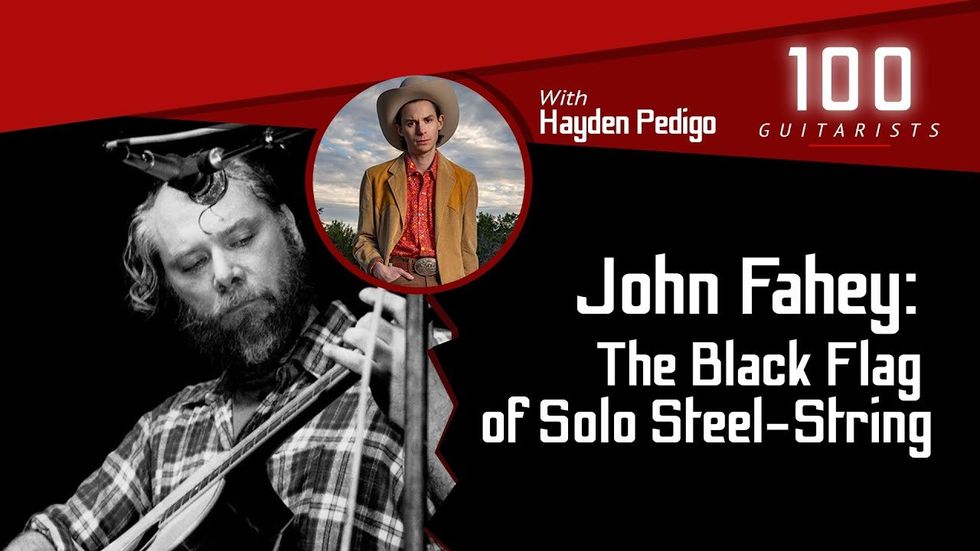
You could call John Fahey the Johnny Appleseed of solo steel-string guitar playing, but Black Flag is probably a more appropriate reference. Like the punk progenitors would do many years later, Fahey not only crafted a uniquely rooted musical approach that would be adopted by legions of practitioners, he self-released his records on his Takoma Records label and hit the road, well before DIY was a common approach.

Transform Your Acoustic Tone with These 4 Pedals
 PG contributor Tom Butwin details four pedalboard options that can help your acoustic sound its best onstage or in the studio. From subtle enhancements to total tone control, these preamps and effects from Grace Design, LR Baggs, and Radial cover the needs of any serious acoustic player.
PG contributor Tom Butwin details four pedalboard options that can help your acoustic sound its best onstage or in the studio. From subtle enhancements to total tone control, these preamps and effects from Grace Design, LR Baggs, and Radial cover the needs of any serious acoustic player.Martin D Jr E StreetLegend Review
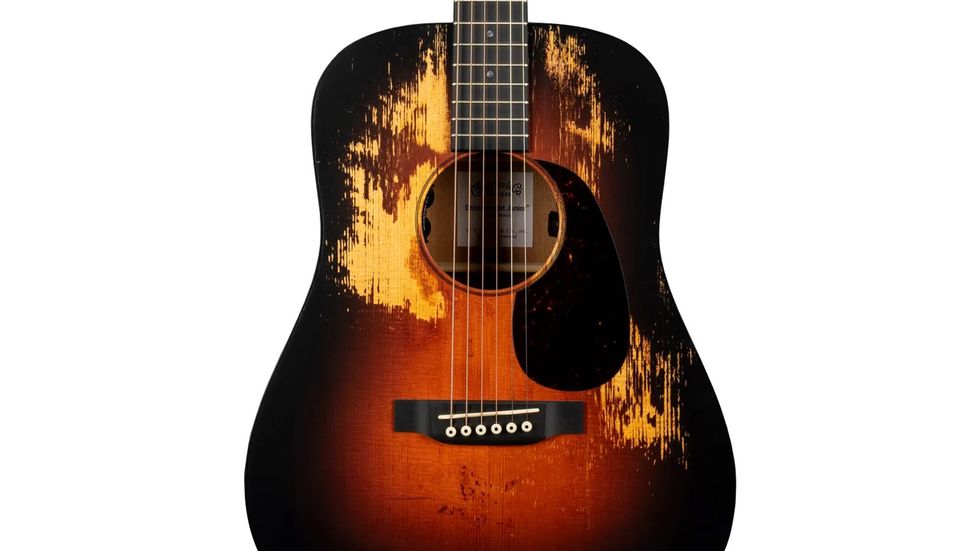
In some ways, it’s hard to know whether to categorize the Martin D Jr E StreetLegend as a backpack or travel guitar. After all, Martin still maintains the LX Little Martin line, which is marketed in very specific terms as a travel instrument. And the D Jr E’s size, which isn’t a whole lot smaller than my Martin 00-15, stretches the boundaries of that classification. But Martin definitely leans into the go-anywhere appeal of the D Jr E and its brethren in the new revamped Junior Series. If the soft case fits, wear it. Assuming it lives, at least partly, in that category, it is among the best sounding travel guitars I’ve ever played. Thanks to the all-solid spruce and sapele body construction, it possesses a warm, woody, and organic voice that is likely made richer by the new, longer 24.9" scale.
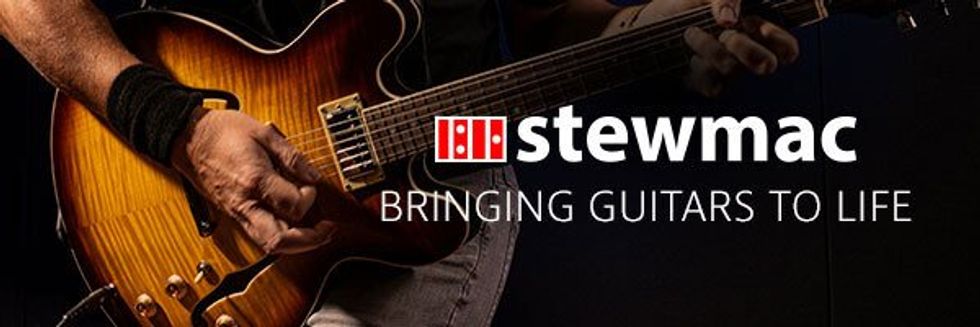
Introducing the Marcus King ES-345
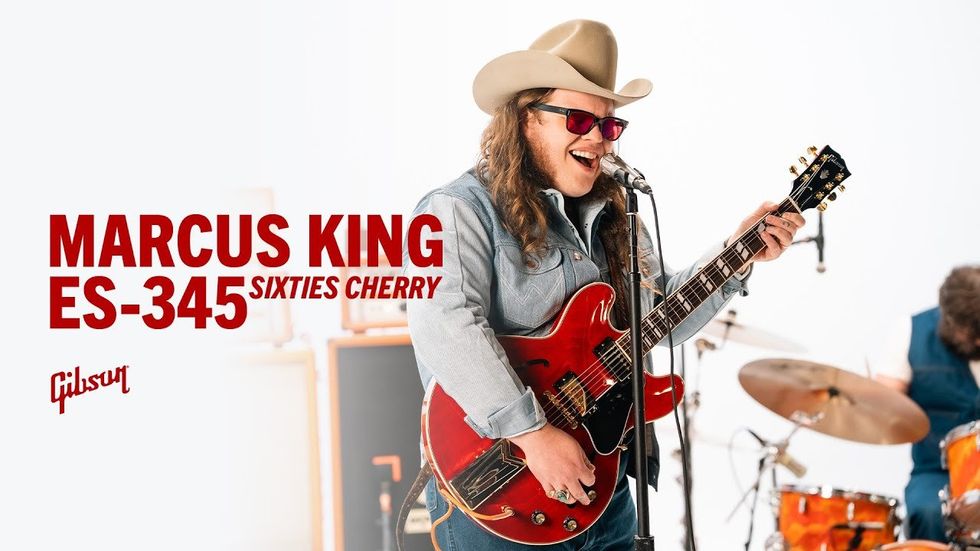
Guitars represent a rich musical legacy and hold a special place in our hearts. The new Marcus King ES-345 is a beautiful example of that tradition—a recreation inspired by his main guitar, “Big Red,” the 1962 ES-345 handed down from his grandfather to his father and finally to him.
Limitless Limitations: A Guide to Better Blues Solos
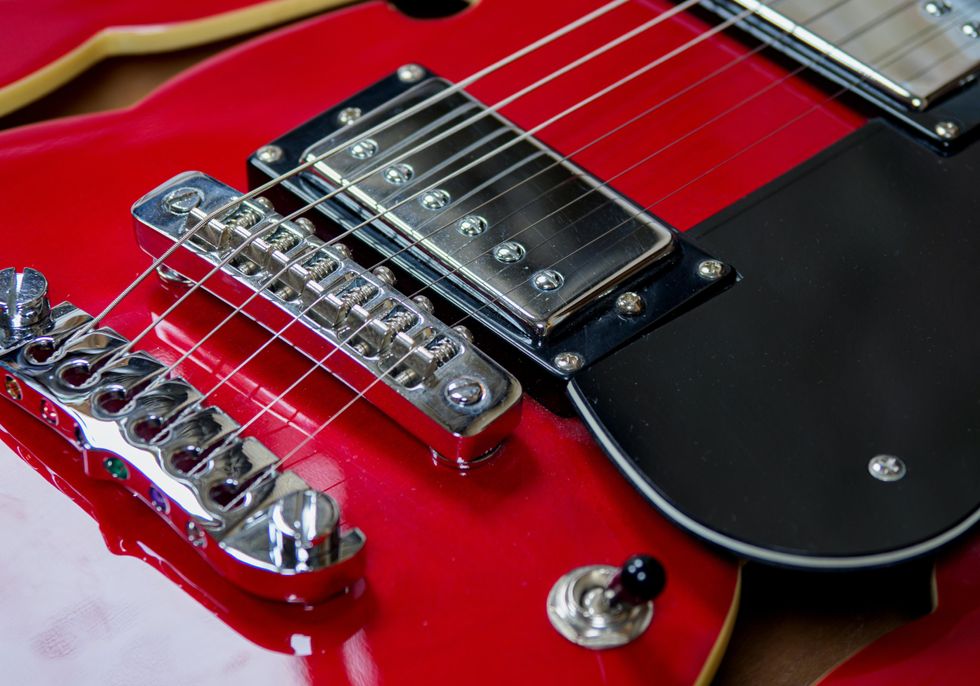
Improvisation is one of the great joys in music that celebrates spontaneity and self-expression. It gives us a chance to explore our instrument and what we naturally hear and feel in an open format. Limitations help challenge us to improvise inside specific parameters and, as a result, can break us out of our typical musical vocabulary.
Latest News
Jackson is launching the X Series Surfcaster & the JS Series Surfcaster
Fender Brings the Heat this Summer with a New Range of Innovative Products
Spector’s Doug Wimbish Euro 4 Signature Now Available

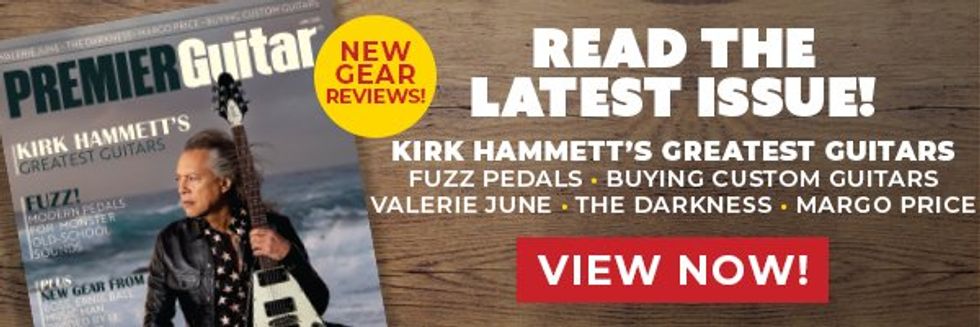
How to Custom Build A Tele from StewMac
Ever dreamed of building your own custom electric guitar from scratch? In this 8-part series, StewMac’s Brock Poling walks you through the entire process — no big workshop or expensive CNC machines required! You just need a little patience, imagination, and attention to detail to create a guitar you'll treasure for a lifetime.
T-Style Electric Guitar Kit
T-Style Electric Guitar Kit If you're new to guitar building this kit's a great way to start: this is the classic electric guitar design that's fun to build, and you'll learn a lot.
Episode #2 - Gluing up the foundation of your guitar
Now the real fun begins! In Episode 2, we’re making all the big decisions that will define your custom electric guitar. What body shape will you choose? What types of wood will bring out the tone you want? What style hardware will complete your vision? Join Brock as he walks through his own design process of crafting a stunning rosewood tele, and sharing expert tips along the way.
Tools and supplies featured in this video include:
Luthier’s Digital Caliper https://www.stewmac.com/item/0447
Stewmac Hygrometer/Thermometer https://www.stewmac.com/item/5814
Fret/Fingerboard Leveler https://www.stewmac.com/item/4579
StewMac Machinist Square Set https://www.stewmac.com/item/4950
Titebond Original https://www.stewmac.com/item/0622
Aluminum Bar Clamp https://www.stewmac.com/item/3714
Stewmac Ultimate Scraper https://www.stewmac.com/item/103469
Episode #3 - Cutting a tele build to its final shape
A great guitar starts with a rock-solid foundation! In Episode 3, Brock walks you through the crucial steps of prepping and gluing up your body blank. Learn how to avoid imperfections in the wood, line everything up perfectly, and clamp it all together for a super strong, stable body.
Episode #4 - Cutting a tele build to its final shape
In Episode 4, Brock walks you through the process of cutting and shaping your guitar body. You’ll learn how to accurately trace your body template, make a rough cut on the bandsaw, and then carefully route the blank to its final shape. By the end of this step, you’ll have a guitar body that looks and feels like the real deal—and you’ll be one step closer to playing your own custom build!
Tools and supplies featured in this video include:
Precision Straightedge https://www.stewmac.com/item/3849
Cam Clamp https://www.stewmac.com/item/3723
Titebond Original Glue https://www.stewmac.com/item/0662
Swivel Handle Clamp https://www.stewmac.com/item/3705
Routing Template for Vintage Tele https://www.stewmac.com/item/2376
Episode #5 - Picking hardware and routing the neck pocket
Now it’s time to gear up! In Episode 5, we’re going shopping for all the essential hardware that will bring your custom guitar to life—pickups, bridges, ferrules, knobs, jack plates, and more! Once the parts are picked, it’s back to the build. Brock shows you how to customize and use a neck pocket template to anticipate an oil finish, then carefully route the neck pocket for a perfect fit. To wrap things up, we true up the body sides using a variety of sanding cauls for a clean, pro-level result.
Tools and supplies featured in this video include:
TV Jones Classic Pickup https://www.stewmac.com/item/6536
Hipshot Hardtail Bridge https://www.stewmac.com/item/3550
Dome Knob https://www.stewmac.com/item/0169
Electrosocket Jack Mount https://www.stewmac.com/item/4284
Neck Mounting Plate https://www.stewmac.com/item/0131
Neck Pocket Routing Template for Fender https://www.stewmac.com/item/2276
Orange Multi-Purpose Tape https://www.stewmac.com/item/0678
Double-stick Tape https://www.stewmac.com/item/2711
Routing Template for Vintage Tele https://www.stewmac.com/item/2376
StewMac Machinist Square Set https://www.stewmac.com/item/4950
Bridge Spatula https://www.stewmac.com/item/4466
3M Stickit Gold Abrasives https://www.stewmac.com/item/5766
StewMac Shop Rule https://www.stewmac.com/item/4905
Episode #6 - How to get PERFECT bridge placement on your guitar
In Episode 6, we’re focusing on one of the most critical steps in your guitar build—precisely locating and mounting the bridge. A well-placed bridge is essential for great playability, intonation, and tuning stability, so getting this right is a must! Brock walks you through his method of using a surrogate guitar neck to dial in the exact bridge position. Then, we temporarily mount the bridge to the body to determine the perfect placement for the string ferrules—a step that can be tricky, but Brock shares a game-changing tip to get it right every time.
Tools and supplies featured in this video include:
Fender Roasted Maple Telecaster Neck https://www.stewmac.com/item/5839-M
StewMac Shop Rule https://www.stewmac.com/item/6246
Cam Clamp https://www.stewmac.com/item/3723
Hipshot Hardtail Bridge https://www.stewmac.com/item/3550
Double-stick Tape https://www.stewmac.com/item/2711
Inlay Tracing Scribe https://www.stewmac.com/item/1672
Bridge Spatula https://www.stewmac.com/item/4466
ColorTone Naphtha https://www.stewmac.com/item/0766
Flush-fit Guitar String Ferrules https://www.stewmac.com/item/0196
Episode #7 - Creative routing for pickup and control cavities
In Episode 7, Brock guides you through routing the pickup and control cavities using customized templates. He covers what to consider when positioning your pickups and explains why making your own jigs is an essential skill for any guitar builder. And if you make a mistake? No problem—Brock shows how to recover from a routing slip using rosewood dust and superglue.
Tools and supplies featured in this video include:
TV Jones Classic Pickup https://www.stewmac.com/item/6536
Double-stick Tape https://www.stewmac.com/item/2711
StewMac Shop Rule https://www.stewmac.com/item/4905
StewMac Pocket File https://www.stewmac.com/item/4160
10 Thin StewMac Super Glue https://www.stewmac.com/item/0010
Episode #8 - Drilling for electronics and prep sanding for finish!
We’ve made it to the final step! In Episode 8, Brock Poling walks you through the last crucial details—drilling holes for the electronic wires, locating and drilling the jack hole, and rounding over the edges for a smooth, comfortable feel. To wrap it all up, Brock carefully sands the entire body, getting it prepped and ready for an oil finish. After this step, your guitar will be fully shaped and ready for a neck!
Tools and supplies featured in this video include:
12” Aircraft Extension Drill Bit https://www.stewmac.com/item/4840
Inlay Tracing Scribe https://www.stewmac.com/item/1672
Orange Multi-Purpose Tape https://www.stewmac.com/item/0678
Cam Clamp https://www.stewmac.com/item/3723
StewMac Shop Rule https://www.stewmac.com/item/4905
Electrosocket Jack Mount https://www.stewmac.com/item/4284
3M Stickit Gold Abrasives https://www.stewmac.com/item/5766
Win a KERNOM MOHO Fuzz and Octave Pedal

We’re giving away a KERNOM MOHO, a wild and expressive fuzz-octave pedal that pushes analog tone into new territory. Don’t miss your chance to win!
Kernom MOHO Multi Fuzz
Kernom MOHO MultiFuzz
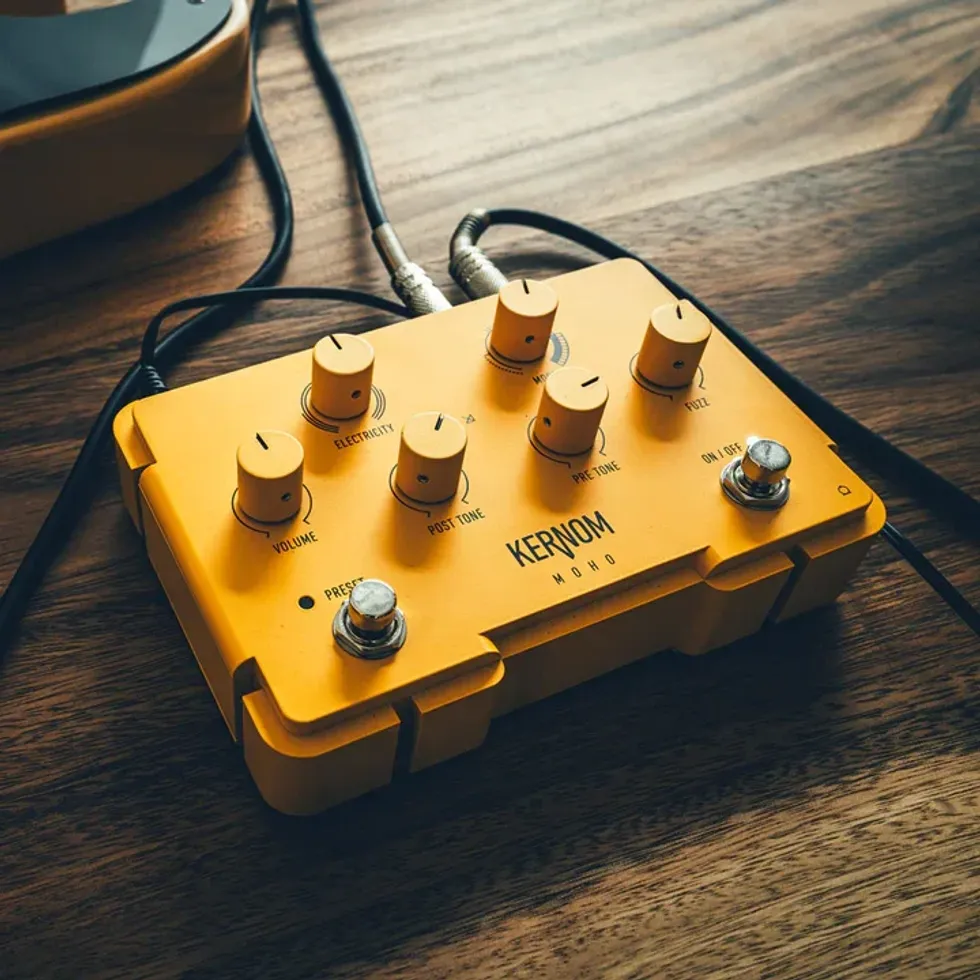 A New Era of Fuzz Exploration
A New Era of Fuzz ExplorationMOHO is your fuzz time machine. Go from Hendrix’s 60s fuzz to Smashing Pumpkins’ wall of sound. Whether you crave the velcro-like bite of under-biased transistors, the roaring sustain of a Big Muff, or the unpredictable chaos of a ring modulator, MOHO morphs between legendary tones and new sonic territories.
- Seamless Morphing: Explore fuzz tones from vintage to modern with the MOOD knob
- Analog Warmth + Digital Precision: No emulation, just real analog fuzz circuits
- Built-in Octaver & Ring Modulator: Create wild, glitchy, and synth-like textures
- MIDI & Preset Control: Save and recall 128 presets for total control
- Expression Pedal Input: Morph between two fuzz settings in real time
“I would say we are estranged”: Lamb of God’s ex-drummer Chris Adler hasn’t spoken to his brother and former bandmate Willie in six years
![[L-R] Chris and Willie Adler](https://guitar.com/wp-content/uploads/2025/06/Chris-Adler-Willie-Adler-hero@2000x1500.jpg)
As Oasis have proven, being in a band with your brother isn’t easy. Lamb Of God have their own case of familial estrangement, with the removal of drummer Chris Adler in 2019 putting a rift between himself and his brother, guitarist Willie Adler.
Speaking to Blabbermouth, Chris reveals that he hasn’t spoken to his brother at all in the 6 years since his Lamb Of God removal. “I wish him all the best; I’m wishing them all the best, and I think about him all the time,” he says. “But I would say we are estranged. Since that email that I got, where he was not even willing to talk to me about it, we haven’t spoken.”
“At this point, I’ve got to work through resentments and regrets and all that stuff,” he notes.“I’m happy where I’m at. I hope [my brother is] happy where he is. Everything is cool with me.”
While Willie still remains in the band, Chris was replaced by drummer Art Cruz. Cruz had initially been a temporary stand-in whilst Chris was out of action in 2018 and 2019, a result of a motorcycle incident. However, Chris seems to think the incident put fear in Lamb Of God’s minds.
Chris believes that his permanent removal was the result of another physical issue he was struggling with – a movement disorder impacting that had been his foot since 2003. “Slowly, it got worse,” he explains. “By around 2016, I was touring with Lamb and Megadeth, and it was making a difference in the show in that there were points where I felt like I couldn’t control it.”
“I started going through all sorts of physical and occupational therapy,” he continues. “I ended up in a place in Richmond called Neurological Associates, which, because of the symptoms, had me bring in my pedals to solve what was going on… and I was diagnosed with a thing called musician’s dystonia.”
Task-specific focal dystonia causes involuntary muscle contractions due to it misfiring of nerves. In Chris’s case, the issue was his foot. “It happens to people who perform a repetitive motion for an extended amount of time,” he explains. “The nerves that are telling my foot to do this are worn out. Eventually, it stops doing what you want it to do.”
“It uses the muscles that [do the] opposite to the intended motion. If I were trying to depress my right foot, often it would lift, shoot to the side, or shoot back. It kept getting worse and worse.”
For drummers, Chris admits the diagnosis can be “a death sentence in many ways”. However, he is opening up about it due to Cannibal Corpse’s Alex Webster and Nickelback drummer Daniel Adair recently coming forward about their own experience with the issue.
However, Chris also believes an element of jealousy lead to his dismissal. “From my perspective, and I don’t mean to speak for anybody, I think when I took the Megadeth gig, that really strained things even further,” he says. “Nobody said, ‘We don’t want you to do it,’ or ‘You’re cheating on us’, [but] that was still the vibe. When Megadeth won a Grammy, that pushed it further.”
Despite Chris looking back and seeing the warning signs, the drummer has still struggled to accept how things turned out. “[It] was very difficult for me,” he reflects. “In many ways, that band was my identity. It’s everything that I worked for. I spiralled.”
“It was a big shock to me… I wasn’t given much of a choice. It was one of those emails: ‘Services no longer required.’ It took a while to dig out of that. I’m happy I did. It could have gone a different way.”
After a period of “spiralling”, Chris sought to re-invent himself. “I was just trying to find myself and even define what chapter two would look like; the only way around dystonia is to re-learn how to play,” he reveals.
To compensate for his nerve issues, Chris now drums with his left foot as his lead foot. “I worked out and talked to the doctors and specialists about changing it,” he says. “I have to build a different connection for it to work. That connection is now strong. I’m able to do it well, but not some of the things I was doing in Lamb.”
The post “I would say we are estranged”: Lamb of God’s ex-drummer Chris Adler hasn’t spoken to his brother and former bandmate Willie in six years appeared first on Guitar.com | All Things Guitar.
Jeff Beck’s iconic Oxblood Les Paul made history as the most expensive LP to sell at auction – now it’s been revived as an Epiphone signature model
“I never felt comfortable in standard. In some ways I felt more pressure because the world was so full of great players in standard – I had no interest in competing with them”: Thurston Moore on Sonic Youth’s Sister, and moving from junk guitars to Fender
A 15-year-old guitarist was brought onstage by Yungblud to riff in front of 30,000 people – and it was only the second time he’d played live
Eastman FullerTone DC’62 review: “a doozy of a player that packs in a lot of quality at a very competitive price”

£899, eastmanguitars.com
Like a barbecue fork plunging into the well-cooked flesh of a vegan sausage, Eastman Guitars has launched a twin-pronged attack on the affordable solidbody guitar market. Maybe you’ve read my review of the first prong, the FullerTone SC’52.
Well this is the second: the DC’62 is another Fender-inspired model, but this time leaning more towards the Stratocaster than the Telecaster.
Designed by California-based luthier Otto D’Ambrosio and made in Eastman’s Beijing workshop, it’s not quite as cheap as the SC’52, probably because it has three pickups and a more complicated vibrato bridge assembly; but if the build quality and tones are up to the same standard, we’re looking at another bargain.
 Photo: Adam Gasson for Guitar.com
Photo: Adam Gasson for Guitar.com
Eastman Guitars FullerTone DC’62 – what is it?
The DC’62 is an HSS S-type. That’s a short sentence with a lot of abbreviations in it, so let’s begin by expanding them all. The ‘DC’ stands for double cutaway, which immediately puts us in Strat territory; the numbers take us to 1962, right in the middle of the pre-CBS rosewood fretboard era; and ‘HSS’ means it has one humbucker and two single-coil pickups. Oh, and ‘S-type’ just means we’re not allowed to call it a Strat because only Fender is allowed to make Strats.
Mind you, as we’ve already seen with the other FullerTone model, Eastman is definitely not making copies here. The basic configuration may be Stratty, but the unique two-bolt neck join certainly isn’t, and neither is the body shape. The neck is a 24-fretter that butts right up against the front pickup, and those pups are again Toneriders – including, at the bridge, the same foil-topped humbucker found in the neck position on the single-cut guitar.
 Photo: Adam Gasson for Guitar.com
Photo: Adam Gasson for Guitar.com
Eastman FullerTone DC’62 – sounds
First of all, I have to say that in my opinion, it’s not much of a looker. I wasn’t mad keen on the SC either, and plenty (including people at this very publication) disagree on that too, but this one doesn’t do anything to alter that impression – subjective as these things always are. That said, it’s also, at least with my skinny thighs, a little uncomfortable to play sitting down: there’s so much body mass to the right side of the waist (not helped by the brass vibrato block) that at times it feels almost in danger of sliding off.
But that’s a micro-gripe. What’s more important is that the neck feels just as slick and welcoming as the one on the SC’52 – and that the acoustic tone, while noticeably less fresh and zingy, has just as much fullness and sustain.
That means there’s plenty of substance for those pickups to work with, and the humbucker gets things off to a strong start. It’s relatively low-output for a ’bucker and does exactly what the ‘H’ in an HSS guitar is there for, offering a punchy tone with some upper-mids bite and none of the weediness you sometimes get from a standard S-type’s bridge pickup.
The two ‘noiseless’ stacked single-coils continue the theme of creamy clarity, with reasonably well balanced output levels and no shortage of quack from the in-between settings. They also cancel hum pretty well. This is basically everything you’d want from a rosewood-board S-type, whether you’re keeping it clean for choppy funk chords or turning up the gain and digging in for blues exploits with a high grimace factor.
The middle pickup is my favourite: full-voiced yet snappy, and letting you introduce an element of cluck without resorting to the full-on phase-cancelling of positions two and four. Hooray for middlies, the unsung heroes of three-pickup guitardom!
 Photo: Adam Gasson for Guitar.com
Photo: Adam Gasson for Guitar.com
Eastman FullerTone DC’62 – should I buy one?
This is not a guitar for people who crave edgy excitement… and in my view it’s not a guitar for hardcore aesthetes who insist that a musical instrument should look as beautiful as it sounds. But if you don’t mind the slightly gawky looks, and like your tones smooth and disciplined rather than raw and peppy, the FullerTone DC’62 is a doozy of a player that packs in a lot of quality at a very competitive price.
Eastman FullerTone DC’62 – alternatives
A similarly polite and sophisticated take on the HSS formula is the Yamaha Pacifica Standard Plus (£1,280); but see also the Canadian-built Godin Session HT (£1,149) and, for something with an ‘F’ on the headstock, the Fender American Performer Stratocaster HSS (£1,389).
 Photo: Adam Gasson for Guitar.com
Photo: Adam Gasson for Guitar.com
The post Eastman FullerTone DC’62 review: “a doozy of a player that packs in a lot of quality at a very competitive price” appeared first on Guitar.com | All Things Guitar.
“I watched her write a song from start to finish on her old beat-up acoustic. I taught myself that song by ear from memory and the rest is history”: Justus West, one of John Mayer’s favorite guitarists, reveals what first got him hooked on the instrument
“Tom Morello said, ‘I can’t see this going on without Jake E. Lee in there somewhere’”: Ozzy Osbourne’s last show will feature an army of heavy metal greats – but it all hinged on Jake E. Lee’s involvement
“I could listen to Vernon’s solo on that song a million times. It’s scary and strange, but in a good way”: Frank Swart of Funkwrench Blues has recruited Vernon Reid, Oz Noy and Mike Stern to his cosmic cause – but there’s one solo that haunts him
“Whatever your opinion is about some music museums, I believe it’s an honor to be recognized”: Wrecking Crew director responds to Carol Kaye’s criticisms of the film – and of the Rock and Roll Hall of Fame
“Our Mick has passed, my heart just hit the ground”: Bad Company and Mott The Hoople’s Mick Ralphs has passed away

Founding member of Mott The Hoople and Bad Company, Mick Ralphs, has passed away at the age of 81.
The Hereford hard rocker had been bed-bound for almost a decade as a result of a stroke suffered back in 2016. It happened after his final-ever performance, a blowout Bad Company gig on 29 October at London’s O2 Arena.
“Our Mick has passed, my heart just hit the ground,” Ralphs’ former Bad Company bandmate, Paul Rodgers, shares in a statement. “He has left us with exceptional songs and memories. He was my friend, my songwriting partner, an amazing and versatile guitarist who had the greatest sense of humour.”
“Our last conversation a few days ago we shared a laugh – but it won’t be our last,” he continues. “There are many memories of Mick that will create laughter. Condolences to everyone who loved him especially his one true love, [Ralphs’ wife] Susie. I will see you in heaven.”
Fellow Bad Company drummer, Simon Kirke, has also issued a statement: “He was a dear friend, a wonderful songwriter and an exceptional guitarist. We will miss him deeply.”
Ralphs’ impact on English rock music can be traced back to the ‘60s. After performing with a slew of acts through his teen years, he would eventually form Silence – a band that would later adopt the name Mott the Hoople after singer Ian Hunter joined the ranks in 1969.
Despite Ralphs embracing the newer injection of glam rock, there was a clear rift between himself and the new frontman. Eventually, he would part ways with the band in 1973 – a decision that would allow him to form Bad Company with drummer Simon Kirke and bassist Boz Burrell the following year.
“I used to always feel a part of Mott, but things have changed a lot since the old days,” Ralphs told Rolling Stone around his 1973 departure. “Ian has sort of taken the initiative now, which is great for the band as a whole but not very good for me as an individual. I should be singing and writing more than I am, but rather than fight with Ian all down the line, I thought it best that I just leave.”
Earlier this year, Ralphs contacted Billboard to acknowledge Bad Company’s planned induction to the Rock and Roll Hall Of Fame this November. “I am elated and think that Bad Company’s induction into the Rock And Roll Hall Of Fame is fantastic!” he said.
Mick Ralphs leaves plenty of marvellous rock tunes in his wake, from Mott The Hoople’s Rock And Roll Queen to their David Bowie-produced 1972 record, All The Young Dudes. The entirety of Bad Company’s Billboard chart-topping 1974 debut, Can’t Get Enough, is also full of top tier rock anthems.
The post “Our Mick has passed, my heart just hit the ground”: Bad Company and Mott The Hoople’s Mick Ralphs has passed away appeared first on Guitar.com | All Things Guitar.
“Keep your cool. This may be a test”: Guns N’ Roses manager claims Slash fed a “little white bunny rabbit” to his pet python during their first meeting

While Guns N’ Roses have calmed down a bit nowadays, they had a reputation for debauchery in the late ‘80s and early ‘90s. And manager Alan Niven has seen it all.
In his new book Sound N’ Fury, Niven charts some of the craziest stories from the rock juggernauts’ heyday, including the time Slash and Izzy Stradlin avoiding getting busted by airport security by taking their entire drug stash in one go. “That’s a fuckin’ waste of good smack,” Stradlin is quoted as saying.
Now, in a new interview with the LA Times, Niven recalls landing the GNR gig, and remembers his rather eventful first meeting with the band.
“Why was I managing Guns N’ Roses? Because nobody else would do it,” he asserts, adding that the firm previously managing the band “could not get away fast enough”.
“No one else would deal with them,” Niven goes on. “Literally, I was not bottom of the barrel, darling – I was underneath the barrel. It was desperation.”
Niven remembers his first meeting with the rockers, and what he now believes was a test by Slash to see if he could hack the job.
He explains how as he entered the house where the meeting was taking place, he walked past a broken toilet and “one of the better-known strippers from [the] Sunset Strip”, before encountering Slash and Stradlin. As the story supposedly goes, after the meeting began, Slash fed a “little white bunny rabbit” to his pet python.
“And I’m sitting there going, ‘Keep your cool. This may be a test. Just go with it and get through it.’ But that was my first GNR meeting,” he concludes.
The members of Guns N’ Roses have left that level of mayhem in the past, and nowadays Slash prefers to spend his time watching YouTube guitar tutorials, apparently – at least according to YouTube instructor Marty Schwartz.
“He said he had some of my instructional stuff saved on his computer and there were some really cool blues-style techniques that he learned from some of my stuff,” Schwartz said. “He was so nice and complimentary… That was one of [those] moments in my life where everything felt validated.”
Alan Niven’s new book Sound N’ Fury is out now.
The post “Keep your cool. This may be a test”: Guns N’ Roses manager claims Slash fed a “little white bunny rabbit” to his pet python during their first meeting appeared first on Guitar.com | All Things Guitar.





